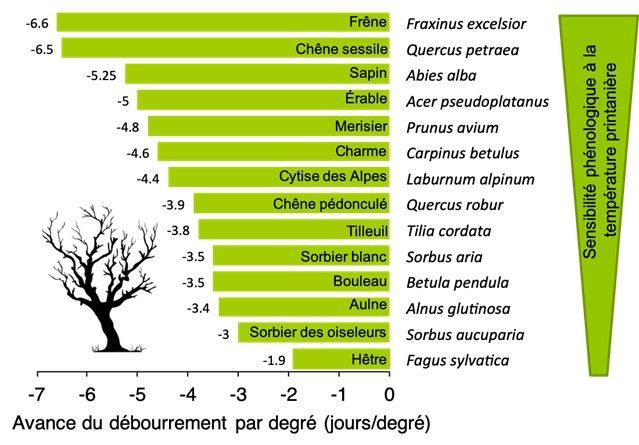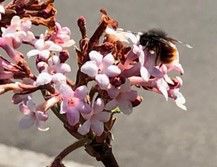Impact of climate change on the phenology in the alpine region (Yann Vitasse, WSL)
Global warming has been particularly pronounced in the Alps with an average annual temperature increase of 0.36°C every 10 years since 1970, which corresponds to an average warming of 1.8°C since 1970. This strong increase in temperature has disrupted the seasonal cycle or organisms, with vegetation and animal activity resuming earlier and earlier in the spring. However, each species expresses its own phenological sensitivity to temperature. For example, within the same forest, we can find very different phenological sensitivities of co-existing trees in response to warming (Fig. 1). Some species, such as oak or ash, are able to advance their leaf-out date by more than 6 days per degree of warming in spring while other species, such as beech, are less sensitive and advance their leaf-out date by only 2 days per degree (Fig. 1). This variety of responses between species could change the competitive balance that has existed in our forests until now, favoring those species that are more likely to extend their growing season following a warming event because this allows them to have faster access to resources such as light, water and nutrients, which in turn guarantees better growth.

Similarly, plant-animal interactions are regulated by species-specific phenological shifts. Different phenological shifts between groups of animals and plants could indeed have an impact on the food chain by causing imbalances between the times when species interact with each other. Since plants are the first link in the food chain, any change in their seasonal cycle may also have an impact on the population dynamics of fungi, herbivores and ultimately predators whose resources and habitats depend on vegetation. Similarly, a desynchronization between the seasonal cycles of different species could compromise certain beneficial interactions. A concrete example is the pollination of plants by bees and other pollinating insects (butterflies, diptera, etc.), which must be well synchronized to ensure good plant reproduction (Fig. 2).
Changes in phenology and plant composition can also affect food availability and quality, which in turn can lead to complex "cascading effects" in the food chain, affecting animal performance and ultimately altering species ranges. The quality and quantity of vegetation for herbivores often changes rapidly in spring and summer. While quantity gradually increases in spring to peak in midsummer, quality is generally optimal soon after vegetation growth begins in spring. Thus, herbivore responses to climate change are generally largely regulated by plant quality and quantity (Rehnus et al., 2020). A good example is the parturition date of the European roe deer, which was found to be better correlated with plant phenology in spring than with altitude in Switzerland (Peláez et al., 2020). In general, species that are less mobile and do not respond as quickly as vegetation to climate warming may be desynchronized with the peak of aboundance of their food resources. Different phenological shifts between species can also be positive if it induces a desynchronisation between a pest and its host species. However, global warming could favour a large number of insect pests by accelerating their reproductive cycle. For example, beetles such as the bark beetle are likely to further weaken conifer trees, especially spruce trees on the Swiss plateau and in the Jura (where they already suffer from drought), as a warmer climate favours shorter reproductive cycles during summer (Jakoby et al., 2019).

In alpine environments, many plant and animal species depend on the date of snowmelt, which is occurring earlier and earlier due to global warming. It is estimated that the date of snowmelt has advanced by about 5 days every 10 years since 1970, which corresponds to a total advance of about 1 month between 1970 and today (Klein et al., 2016). However, early snowmelt can have very different consequences for different species. For example, it leads to earlier vegetation onset in spring, which in turn increases the reproductive success of rock ptarmigan (Novoa et al., 2008), but decreases the litter size of alpine marmots (Tafani et al., 2013). Similarly, an earlier start to vegetation due to warming may increase the survival of ibex (Capra ibex) due to earlier access to food resources in spring (Pettorelli et al., 2007), but reduced snow cover in winter may also reduce the quality of vegetation available in spring (Robinson & Merrill, 2012). The consequences of warming may thus lead to complex responses that need to be further studied at the ecosystem scale and not only at the species scale.
A recent meta-analysis conducted on the phenology of plants and animals in the European Alpine region over the past decades and which includes data from citizen science programs confirms that the phenological shifts following warming are very different for different taxonomic groups (Vitasse et al., 2021). While terrestrial insects, reptiles, migratory birds and plants have responded strongly to climate warming by advancing their spring activity by an average of 2 to 8 days per decade, other groups of organisms such as breeding birds, amphibians and aquatic insects have shifted their spring activity less or not at all (Fig. 3).
Research on the impact of global warming on phenological shifts between different groups of animals and plants interacting within the same ecosystem is still emerging. Many other complex indirect interactions between species have not yet been studied because very little data is systematically collected on several taxonomic groups within the same ecosystem. However, the way in which, for example, winter weather conditions, insect diapause, bird activity and the start of vegetation in spring are synchronized will determine the ability of many animals to adapt to climate change. Citizen science programs could help scientists to fill these gaps in the future by allowing a huge number of observations on multiple groups of organisms to be pooled and analyzed.
References
Fu YH, Zhao H, Piao S et al. (2015) Declining global warming effects on the phenology of spring leaf unfolding. Nature, 526, 104–107.
Jakoby O, Lischke H, Wermelinger B (2019) Climate change alters elevational phenology patterns of the European spruce bark beetle (Ips typographus). Global Change Biology, 25, 4048–4063.
Klein G, Vitasse Y, Rixen C, Marty C, Rebetez M (2016) Shorter snow cover duration since 1970 in the Swiss Alps due to earlier snowmelt more than to later snow onset. Climatic Change, 139, 637–649.
Novoa C, Besnard A, Brenot JF, Ellison LN (2008) Effect of weather on the reproductive rate of Rock Ptarmigan Lagopus muta in the eastern Pyrenees. Ibis, 150, 270–278.
Peláez M, Gaillard JM, Bollmann K, Heurich M, Rehnus M (2020) Large scale variation in birth timing and synchrony of a large herbivore along the latitudinal and altitudinal gradients. Journal of Animal Ecology.
Pettorelli N, Pelletier F, Hardenberg Av, Festa-Bianchet M, Côté SD (2007) Early onset of vegetation growth vs. rapid green‐up: Impacts on juvenile mountain ungulates. Ecology, 88, 381–390.
Rehnus M, Peláez M, Bollmann K (2020) Advancing plant phenology causes an increasing trophic mismatch in an income breeder across a wide elevational range. Ecosphere, 11, e03144.
Robinson BG, Merrill EH (2012) The influence of snow on the functional response of grazing ungulates. Oikos, 121, 28–34.
Tafani M, Cohas A, Bonenfant C, Gaillard J-M, Allainé D (2013) Decreasing litter size of marmots over time: a life history response to climate change? Ecology, 94, 580–586.
Vitasse Y, Delzon S, Dufrene E, Pontailler JY, Louvet JM, Kremer A, Michalet R (2009a) Leaf phenology sensitivity to temperature in European trees: do within-species populations exhibit similar responses? Agricultural and Forest Meteorology, 149, 735–744.
Vitasse Y, Hoch G, Randin CF, Lenz A, Kollas C, Scheepens JF, Körner C (2013) Elevational adaptation and plasticity in seedling phenology of temperate deciduous tree species. Oecologia, 171, 663–678.
Vitasse Y, Porte AJ, Kremer A, Michalet R, Delzon S (2009b) Responses of canopy duration to temperature changes in four temperate tree species: relative contributions of spring and autumn leaf phenology. Oecologia, 161, 187–198.
Vitasse Y, Ursenbacher S, Klein G et al. (2021) Phenological and elevational shifts of plants, animals and fungi under climate change in the European Alps. Biological Reviews.

